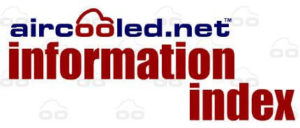VW VIN Number Anatomy Lesson
What is a Vehicle Identification Number (VIN)?
 The VIN number on your VW can help you to identify the origin of your VW and it may also give you clues regarding the stock parts that were used in your vehicle when it was built. Early VINs were not standardized between manufacturers, nor were they called “VIN”s yet! VW used a combination of two numbers: The Chassis Number, and the Engine Code to convey information about their vehicles.
The VIN number on your VW can help you to identify the origin of your VW and it may also give you clues regarding the stock parts that were used in your vehicle when it was built. Early VINs were not standardized between manufacturers, nor were they called “VIN”s yet! VW used a combination of two numbers: The Chassis Number, and the Engine Code to convey information about their vehicles.
A format for Vehicle Identification Numbers was “officially” outlined in February 1977, and shortly afterward, US National Highway Traffic Safety Administration began requiring that all road vehicles contain a 17-character VIN. VIN numbers are comprised of only numbers (1-0) and capital letters (A – Z), however, the letters I, O and Q are never used in order to avoid confusion in reading. There are no signs or spaces are allowed in a VIN.
Where to Find Your VW VIN
VINs can be found in several locations on a car, but the most common places are:
– On the door frame/door post of the front doors (usually driver side, but sometimes on the passenger side)
– On the dash near the windshield
– On the engine itself (machined pad on front of engine)
– On the car’s firewall
– In the left-hand inner wheel arch
– On the steering wheel/steering column
– On your car’s title, registration, guarantee/maintenance book or on the declarations page of your auto insurance policy
How To Interpret a VW VIN
The position of each letter or number in the VIN code reveals important information about where and when your VW was made, the type of engine it has, the model or series of the car, various equipment/attributes and its production sequence. Each character or digit has a particular purpose as follows:
1st Character: The 1st character of your VW’s vehicle identification number identifies the country where it was manufactured. Here are some common Country of Manufacture Codes
1 or 4 USA
2 Canada
3 Mexico
J Japan
K Korea
S England
W Germany
Z Italy
2nd Character: The 2nd character in your VIN will be the letter “V”, which specifies that the manufacturer is “VOLKSWAGEN”.
3rd Character: The 3rd character in your VW’s vehicle identification number indicates the vehicle type or manufacturing division.
4th – 8th Character: The 4th through 8th characters in your VW’s VIN reveal information about your vehicle’s features an/or attributes, such as body style, engine type, model, series, etc.
9th Character: The 9th character in your VW’s vehicle identification number is a VIN accuracy check digit. This check digit is either a single number, or the letter “X”, and is used to verify the accuracy of the transcription of the vehicle identification number. After all the other characters in the VIN have been assigned, this check digit is calculated from a mathematical formula. The correct numeric remainder that results from the computation – (0-9) – is inserted as the check digit. However, if the remainder is 10 the letter “X” is used to indicate that value.
10th Character: The 10th character in your VW VIN tells you the model year. (This varies somewhat among car manufacturers – see the chart in the “Here’s How to Find Your Car’s VIN” section below for specific locations by car make.)
VIN Character – Model Year Codes |
|||||||||||
1971 |
1972 |
1973 |
1974 |
1975 |
1976 |
1977 |
1978 |
|
|
||
1 |
2 |
3 |
4 |
5 |
6 |
7 |
8 |
|
|
||
1979 |
1980 |
1981 |
1982 |
1983 |
1984 | 1985 | |||||
9 |
A |
B |
C |
D |
E | F | |||||
11th Character: The 11th character in your VW vehicle identification number reveals the assembly plant for the vehicle.
12th – 17th Character: The 12th through the 17th character in your VIN indicate the sequence of the vehicle for production as it rolled off the manufacturer’s assembly line. The last four characters are always numeric.
These last six characters are perhaps the most critical portion of the VIN for most European cars. Because of mid-year production changes by car makers, these can be extremely important in identifying the proper part numbers for ignition, fuel, emission and engine components. These types of parts are often listed with the caveat that they fit vehicles up to a particular VIN or before/after a particular VIN sequence.
NOTES
‘Z’ is used by VW as a ‘filler’ character in VIN codes. This means the information for that particular part of the VIN is not provided.
Production year runs from August to July. So a car manufactured in October 1992, will be a 1993 model according to the VIN.
DECODERS
Source: http://www.autohausaz.com/vw-auto-parts/vw-vehicle-identification-numbers.html